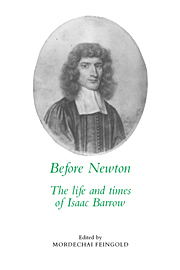Book contents
- Frontmatter
- Contents
- List of contributors
- Editor's preface
- 1 Isaac Barrow: divine, scholar, mathematician
- 2 The Optical Lectures and the foundations of the theory of optical imagery
- 3 Barrow's mathematics: between ancients and moderns
- 4 Isaac Barrow's academic milieu: Interregnum and Restoration Cambridge
- 5 Barrow as a scholar
- 6 The preacher
- 7 Isaac Barrow's library
- Index
3 - Barrow's mathematics: between ancients and moderns
Published online by Cambridge University Press: 05 November 2011
- Frontmatter
- Contents
- List of contributors
- Editor's preface
- 1 Isaac Barrow: divine, scholar, mathematician
- 2 The Optical Lectures and the foundations of the theory of optical imagery
- 3 Barrow's mathematics: between ancients and moderns
- 4 Isaac Barrow's academic milieu: Interregnum and Restoration Cambridge
- 5 Barrow as a scholar
- 6 The preacher
- 7 Isaac Barrow's library
- Index
Summary
Introduction
Isaac Barrow's earliest mathematical publication, an edition of Euclid's Elements in a symbolic shorthand inspired in part by Pierre Herigone, dates from 1656. But his mathematical career began in earnest following his return from a four-year tour of the Continent and study in Italy. Finally seated in 1660 as Regius Professor of Greek at his alma mater, Trinity College, he began in 1662 to supplement his living through the professorship of geometry at Gresham College. His lectures from that time have not survived, and it would be difficult to say with any confidence how much of what he later presented as Lucasian Professor stemmed from them. It was in the latter capacity, from 1663 to 1669, that he composed the bulk of his work, recorded in his three series of lectures on mathematics, optics, and geometry.
Lucas's executors prescribed the holder of the chair as a “man of good repute and honest conversation, at least a Master of Arts, deeply learned, and imbued with expertise above all in the mathematical sciences.” Barrow's correspondence with John Collins gives a picture of what the new Lucasian Professor knew about his subject on his accession. He spoke of “that little study I have employed upon mathematical businesses, being never designed to any other use than the bare knowledge of the general reason of things, as a scholar, and no further.” He was being modest. Beyond the corpus of the ancient mathematics, his “little study” by then included the writings of Mersenne, Descartes, Pascal (Dettonville), Huygens, Viviani, Torricelli, Renaldini (whom Barrow had met in Florence), Snel, Alsted, and Kersey.
- Type
- Chapter
- Information
- Before NewtonThe Life and Times of Isaac Barrow, pp. 179 - 249Publisher: Cambridge University PressPrint publication year: 1990
- 18
- Cited by



